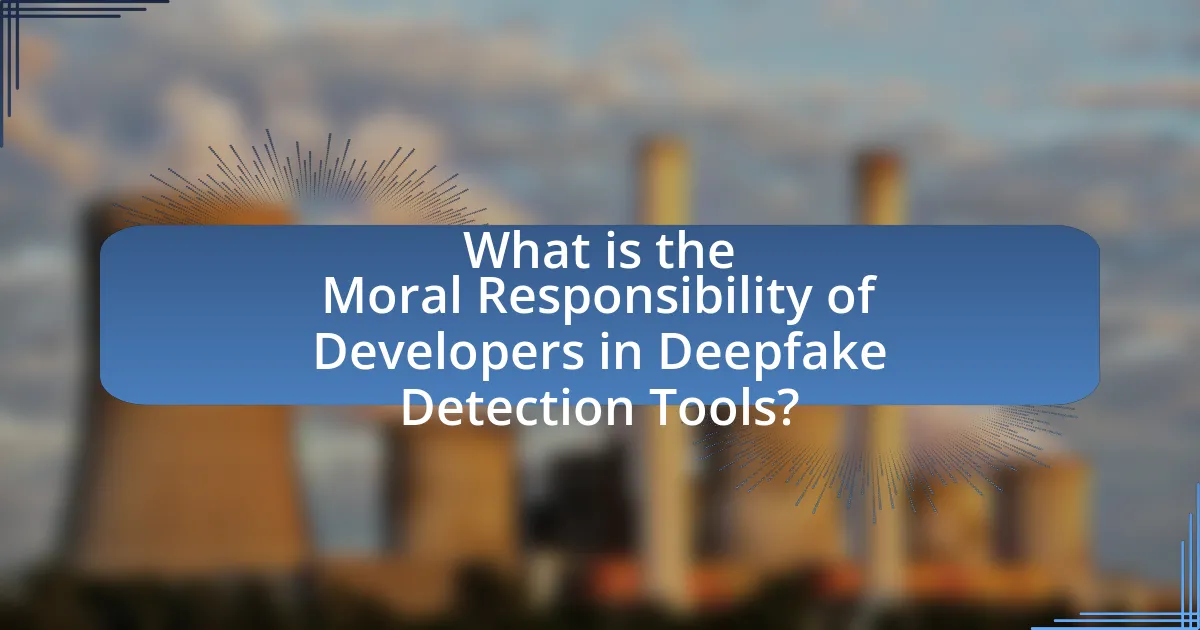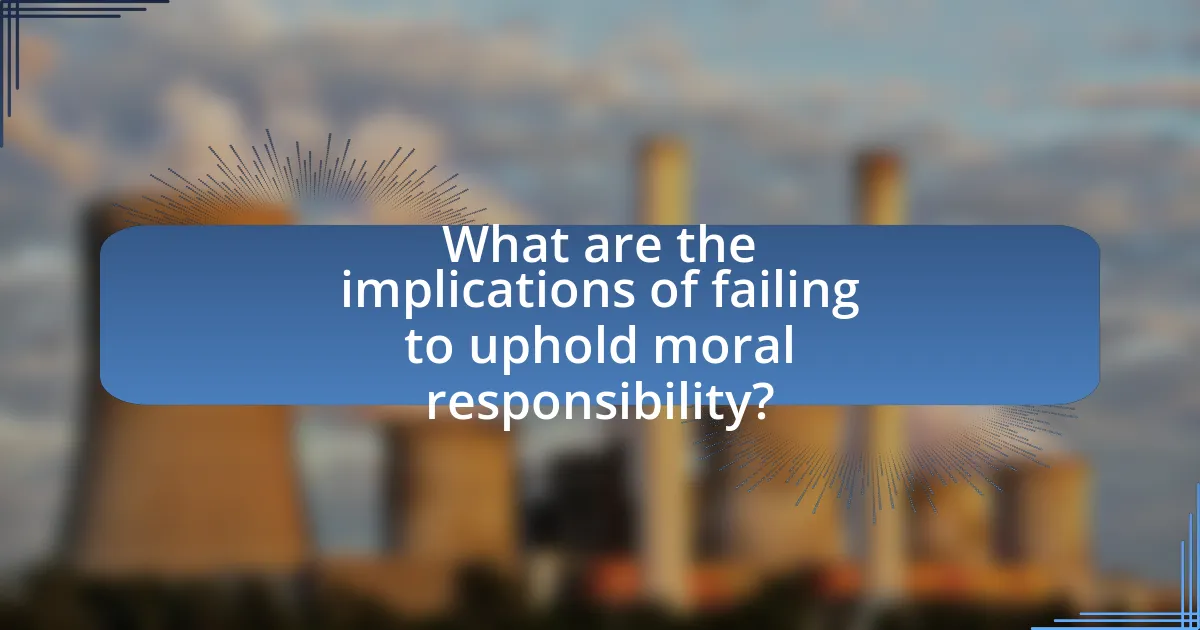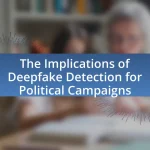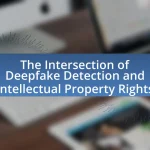The article focuses on the moral responsibility of developers in creating deepfake detection tools. It emphasizes the necessity for these developers to ensure their technologies are effective, accurate, and ethically used to combat misinformation and protect individuals from harm. Key discussions include the ethical frameworks guiding developers, the societal implications of deepfakes, the technical functioning of detection tools, and the challenges developers face in balancing innovation with moral responsibility. Additionally, the article outlines best practices for developers to mitigate risks associated with deepfake technology and highlights the importance of collaboration with ethicists to enhance tool effectiveness.

What is the Moral Responsibility of Developers in Deepfake Detection Tools?
Developers of deepfake detection tools have a moral responsibility to ensure their technologies are effective, accurate, and used ethically. This responsibility includes creating tools that can reliably identify manipulated media to prevent misinformation and protect individuals from potential harm, such as defamation or privacy violations. For instance, a study published in the journal “Nature” highlights that deepfake technology can be used maliciously, emphasizing the need for robust detection methods to mitigate risks associated with its misuse. Furthermore, developers must consider the implications of their tools being used in harmful ways and strive to implement safeguards that promote responsible usage.
Why is moral responsibility important in the context of technology?
Moral responsibility is crucial in the context of technology because it ensures that developers consider the ethical implications of their creations, particularly in areas like deepfake detection tools. Developers hold the power to influence societal norms and behaviors through technology, and without a strong sense of moral responsibility, they may inadvertently contribute to misinformation, privacy violations, or harm to individuals. For instance, the misuse of deepfake technology can lead to reputational damage or manipulation of public opinion, highlighting the need for developers to prioritize ethical standards in their work. By embracing moral responsibility, developers can create tools that not only advance technology but also protect users and uphold societal values.
How does moral responsibility influence developer decisions?
Moral responsibility significantly influences developer decisions by guiding ethical considerations in the design and implementation of technology. Developers are increasingly aware that their creations can have profound societal impacts, particularly in sensitive areas like deepfake detection tools, where misuse can lead to misinformation and harm. For instance, a study by the MIT Media Lab highlights that developers who prioritize ethical standards are more likely to create tools that mitigate risks associated with deepfakes, such as identity theft and reputational damage. This awareness drives developers to incorporate features that enhance transparency and accountability, ensuring that their technologies serve the public good while minimizing potential negative consequences.
What ethical frameworks can guide developers in this area?
Developers in the area of deepfake detection tools can be guided by ethical frameworks such as utilitarianism, deontological ethics, and virtue ethics. Utilitarianism emphasizes the greatest good for the greatest number, encouraging developers to create tools that minimize harm and maximize societal benefits, particularly in preventing misinformation. Deontological ethics focuses on adherence to rules and duties, urging developers to uphold principles of honesty and integrity in their work, ensuring that their tools are used responsibly. Virtue ethics highlights the importance of character and moral virtues, prompting developers to cultivate traits like honesty and accountability in their practices. These frameworks collectively provide a comprehensive ethical foundation for developers to navigate the complexities of deepfake technology and its societal implications.
What are deepfake detection tools and their significance?
Deepfake detection tools are technologies designed to identify manipulated media, particularly videos and audio, that have been altered to misrepresent reality. Their significance lies in their ability to combat misinformation, protect individuals from identity theft, and uphold the integrity of information in digital communications. For instance, a study by the University of California, Berkeley, found that deepfake detection algorithms can achieve over 90% accuracy in identifying synthetic media, highlighting their effectiveness in safeguarding against deceptive content.
How do deepfake detection tools function?
Deepfake detection tools function by analyzing digital content to identify signs of manipulation. These tools utilize machine learning algorithms that are trained on large datasets of both authentic and deepfake media, allowing them to recognize subtle inconsistencies in visual and audio elements. For instance, they may examine facial movements, inconsistencies in lighting, or unnatural speech patterns that deviate from typical human behavior. Research has shown that deepfake detection models can achieve accuracy rates exceeding 90% when properly trained, as demonstrated in studies like “Deepfake Detection: A Survey” published in IEEE Access by authors including Yuezun Li and Junjie Wu.
What are the potential consequences of deepfakes on society?
The potential consequences of deepfakes on society include the erosion of trust in media, increased misinformation, and potential harm to individuals’ reputations. Deepfakes can manipulate public perception by creating realistic but false representations of events or statements, leading to confusion and skepticism about authentic content. For instance, a study by the University of California, Berkeley, found that 85% of participants could not distinguish between real and deepfake videos, highlighting the risk of misinformation spreading rapidly. Additionally, deepfakes can be used for malicious purposes, such as defamation or harassment, which can have severe psychological and social impacts on victims.
What role do developers play in the creation of deepfake detection tools?
Developers are crucial in creating deepfake detection tools as they design, implement, and optimize algorithms that identify manipulated media. Their expertise in machine learning and artificial intelligence enables them to develop models that analyze visual and audio data for inconsistencies indicative of deepfakes. For instance, developers utilize techniques such as convolutional neural networks (CNNs) to detect subtle artifacts that human eyes may overlook. This technical foundation is essential, as research indicates that advanced detection tools can achieve accuracy rates exceeding 90% in identifying deepfakes, demonstrating the significant impact of developers’ work in combating misinformation and protecting digital integrity.
What skills and knowledge are essential for developers in this field?
Developers in the field of deepfake detection tools must possess a strong foundation in machine learning, computer vision, and ethical considerations. Machine learning skills are essential for creating algorithms that can identify manipulated media, while computer vision knowledge enables developers to analyze visual content effectively. Additionally, understanding ethical implications is crucial, as developers must navigate the moral responsibilities associated with the potential misuse of deepfake technology. Research indicates that a combination of technical expertise and ethical awareness is vital for responsible development in this area, as highlighted in studies on AI ethics and technology impact.
How can developers ensure the effectiveness of detection tools?
Developers can ensure the effectiveness of detection tools by implementing rigorous testing and validation processes. This involves using diverse datasets that include various types of deepfakes to train the detection algorithms, thereby improving their accuracy and robustness. Research indicates that tools trained on a wide range of examples perform better in real-world scenarios, as evidenced by a study published in the journal “Nature” which found that detection systems trained on extensive and varied datasets achieved up to 95% accuracy in identifying manipulated media. Additionally, continuous updates and improvements based on user feedback and emerging deepfake techniques are crucial for maintaining effectiveness over time.
How can developers balance innovation and ethical considerations?
Developers can balance innovation and ethical considerations by implementing ethical guidelines and frameworks during the development process. By adhering to established ethical standards, such as those proposed by organizations like the IEEE and ACM, developers can ensure that their innovations do not harm individuals or society. For instance, the IEEE’s Ethically Aligned Design emphasizes the importance of transparency, accountability, and fairness in technology development, which can guide developers in creating deepfake detection tools that respect user privacy and prevent misuse. Additionally, conducting regular ethical reviews and engaging with stakeholders can help identify potential ethical dilemmas early in the development cycle, allowing for adjustments that prioritize ethical implications alongside technological advancements.
What challenges do developers face regarding moral responsibility?
Developers face significant challenges regarding moral responsibility, particularly in the context of deepfake detection tools. One primary challenge is the ethical implications of their technology, as deepfakes can be used for malicious purposes, such as misinformation or defamation. Developers must navigate the fine line between innovation and potential harm, ensuring that their tools are not misused. Additionally, there is the challenge of accountability; when deepfake technology is misapplied, it can be difficult to determine who is responsible—the developer, the user, or the platform hosting the content. This ambiguity complicates the moral landscape, as developers may feel pressured to prioritize functionality over ethical considerations. Furthermore, the rapid pace of technological advancement often outstrips existing regulations, leaving developers in a gray area where they must make ethical decisions without clear guidelines.

What are the implications of failing to uphold moral responsibility?
Failing to uphold moral responsibility in the context of developing deepfake detection tools can lead to significant societal harm, including the proliferation of misinformation and erosion of trust in digital media. When developers neglect their ethical obligations, they contribute to the misuse of deepfake technology, which can result in reputational damage to individuals, manipulation of public opinion, and potential legal ramifications. For instance, a study by the Brookings Institution highlights that deepfakes can undermine democratic processes by spreading false information during elections, thereby influencing voter behavior and public perception. This illustrates that the implications of neglecting moral responsibility extend beyond individual developers to affect societal integrity and democratic institutions.
What risks arise from inadequate deepfake detection tools?
Inadequate deepfake detection tools pose significant risks, including the spread of misinformation, erosion of trust in media, and potential harm to individuals’ reputations. The proliferation of deepfakes can lead to the manipulation of public opinion, as seen in instances where altered videos have influenced political events or social movements. For example, a study by the University of California, Berkeley, found that deepfakes could sway viewers’ perceptions of political candidates, demonstrating the potential for misinformation to impact democratic processes. Furthermore, individuals may suffer reputational damage from malicious deepfakes, which can lead to harassment or defamation. The lack of effective detection tools exacerbates these issues, allowing harmful content to proliferate unchecked.
How can misinformation spread due to ineffective detection?
Ineffective detection of misinformation allows false information to proliferate rapidly across digital platforms. When detection systems fail to identify deepfakes or misleading content, users are more likely to share and engage with this misinformation, amplifying its reach. For instance, a study by the MIT Media Lab found that false news spreads six times faster than true news on social media, primarily due to the inability of algorithms to accurately flag misleading content. This highlights the critical role that developers of detection tools play in mitigating the spread of misinformation; their failure to create effective solutions directly contributes to the persistence and escalation of false narratives online.
What are the potential legal repercussions for developers?
Developers of deepfake detection tools may face legal repercussions such as liability for defamation, copyright infringement, or violations of privacy laws. These legal issues arise when the tools are misused or when they inadvertently produce false positives that harm individuals’ reputations. For instance, if a detection tool incorrectly identifies a legitimate video as a deepfake, it could lead to reputational damage for the individual depicted, resulting in potential lawsuits for defamation. Additionally, developers must navigate copyright laws, as using copyrighted material without permission in training datasets can lead to infringement claims. Privacy laws, such as the General Data Protection Regulation (GDPR) in Europe, impose strict guidelines on data usage, and non-compliance can result in significant fines.
How can developers mitigate risks associated with deepfake technology?
Developers can mitigate risks associated with deepfake technology by implementing robust detection algorithms and promoting transparency in the use of such technologies. By utilizing machine learning techniques, developers can create systems that analyze video and audio content for inconsistencies that indicate manipulation. Research shows that deepfake detection tools can achieve over 90% accuracy in identifying altered media, as demonstrated in studies like “Deepfake Detection: A Survey” published in IEEE Access. Additionally, developers should establish ethical guidelines and collaborate with policymakers to ensure responsible usage, thereby reducing the potential for misuse in areas such as misinformation and identity theft.
What best practices should developers follow in tool development?
Developers should prioritize user privacy and data security in tool development. This involves implementing strong encryption methods, ensuring compliance with data protection regulations like GDPR, and minimizing data collection to only what is necessary for functionality. For instance, a study by the International Association of Privacy Professionals highlights that organizations that prioritize privacy by design can reduce the risk of data breaches by up to 50%. Additionally, developers should engage in thorough testing and validation of their tools to ensure accuracy and reliability, as evidenced by the National Institute of Standards and Technology’s guidelines on evaluating deepfake detection technologies. By following these best practices, developers can create tools that are not only effective but also ethically responsible.
How can collaboration with ethicists enhance tool effectiveness?
Collaboration with ethicists can enhance tool effectiveness by ensuring that deepfake detection tools are designed with ethical considerations in mind, which improves their reliability and public trust. Ethicists provide critical insights into the potential societal impacts of these tools, guiding developers to address biases and privacy concerns that may arise during deployment. For instance, a study by the Partnership on AI highlights that incorporating ethical frameworks can lead to more robust algorithms that are less likely to produce false positives or negatives, thereby increasing their overall effectiveness in real-world applications.

What future considerations should developers keep in mind?
Developers should prioritize ethical implications and societal impact when creating deepfake detection tools. As deepfake technology evolves, the potential for misuse increases, necessitating robust ethical guidelines to prevent harm. For instance, developers must consider the accuracy and reliability of their tools, as false positives can unjustly damage reputations, while false negatives can allow harmful content to proliferate. Additionally, developers should engage with stakeholders, including policymakers and affected communities, to ensure that their tools address real-world concerns and promote transparency. Research indicates that user trust is critical; a study by the Pew Research Center found that 86% of Americans believe that technology companies should be held accountable for the misuse of their products. Therefore, developers must remain vigilant about the ethical landscape and adapt their approaches accordingly.
How will advancements in AI impact deepfake detection tools?
Advancements in AI will significantly enhance deepfake detection tools by improving their accuracy and efficiency. As AI algorithms evolve, they will be able to analyze and identify subtle inconsistencies in deepfake content that are often imperceptible to the human eye. For instance, machine learning models can be trained on vast datasets of both authentic and manipulated media, allowing them to recognize patterns and anomalies that indicate deepfakes. Research has shown that state-of-the-art detection methods, such as those utilizing convolutional neural networks, can achieve detection rates exceeding 90% in controlled environments. This improvement in detection capabilities is crucial for addressing the ethical concerns surrounding the misuse of deepfakes, as developers bear the moral responsibility to ensure their tools are effective in combating misinformation and protecting individuals’ rights.
What emerging technologies should developers be aware of?
Developers should be aware of artificial intelligence (AI), blockchain technology, and quantum computing as emerging technologies. AI is crucial for enhancing deepfake detection tools, enabling more accurate identification of manipulated media through advanced algorithms. Blockchain technology offers a decentralized approach to verifying the authenticity of digital content, which can help combat misinformation. Quantum computing, while still in its infancy, has the potential to revolutionize data processing and encryption, impacting how developers create secure applications. These technologies are increasingly relevant as the demand for ethical solutions in digital content verification grows.
How can developers prepare for future ethical dilemmas?
Developers can prepare for future ethical dilemmas by actively engaging in ethical training and adopting a framework for ethical decision-making. This proactive approach equips developers with the necessary skills to navigate complex moral situations, especially in the context of deepfake detection tools, where the potential for misuse is significant. Research indicates that organizations that implement ethics training programs see a 30% increase in ethical decision-making among employees, highlighting the effectiveness of such initiatives. Additionally, developers should stay informed about emerging technologies and their societal impacts, as understanding the implications of their work fosters a culture of responsibility and accountability.
What practical steps can developers take to uphold their moral responsibility?
Developers can uphold their moral responsibility by implementing ethical guidelines and best practices in the creation of deepfake detection tools. This includes conducting thorough research on the implications of deepfake technology, ensuring transparency in algorithms, and prioritizing user privacy. For instance, developers should engage in regular audits of their systems to identify and mitigate biases, as studies have shown that biased algorithms can lead to harmful societal impacts. Additionally, collaborating with ethicists and stakeholders can provide diverse perspectives that enhance the ethical framework guiding their work. By adhering to these steps, developers can contribute to a more responsible and ethical deployment of deepfake detection technologies.


